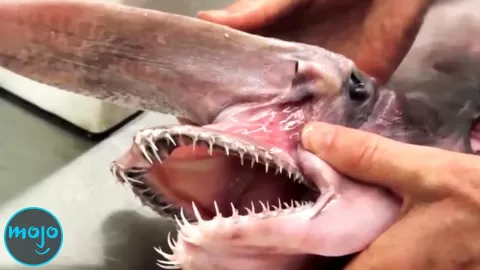Top 10 Disturbing Scientific Deep Sea Discoveries

#10: Vampire Squid
Vampyroteuthis infernalis dwells in the shadowy ocean depths. It’s actually neither a true squid — nor a vampire — but shares characteristics with both squids and octopuses. This cephalopod boasts a dark, velvety mantle and large, globular eyes that shine red or blue, depending on the light. Its eight arms are connected by a webbed cloak, adorned with bioluminescent photophores that can emit light to confuse predators or lure prey. Unique among deep-sea dwellers, it feeds primarily on marine snow — organic debris falling from upper waters — making it a “detritivore.” The Vampire Squid's ability to thrive in such inhospitable environments highlights its remarkable evolutionary adaptations.
#9: Blob Sculpin
Psychrolutes phrictus is a notably peculiar fish found in the depths along the U.S. West Coast. With its gelatinous, blob-like appearance, it bears a striking resemblance to the alien entity in the horror movie "The Blob." This fish's unique morphology allows it to withstand the immense pressure of the deep sea. Its diet likely consists of small invertebrates found on the ocean floor, captured through a method of indiscriminate trawling that often brings it into contact with commercial fishing operations that target species like crabs. The Blob Sculpin's unusual form makes it particularly interesting for researchers studying the adaptations of organisms to extreme conditions.
#8: Sea Pigs
The 10 Most Disturbing Scientific Discoveries Ever
Belonging to the genus Scotoplanes, sea pigs are a unique type of sea cucumber. These creatures are characterized by their plump, pinkish appearance and several leg-like appendages that facilitate movement across the ocean floor. They are commonly found in large groups, sometimes numbering in the hundreds, as they scavenge for organic particles in the deep-sea mud. They play a crucial role in the ecosystem by recycling nutrients and supporting the abyssal food web. Despite their cool name, sea pigs are invertebrates and have little in common with terrestrial pigs, aside from their somewhat rounded body shape.
#7: Goblin Shark
Mitsukurina owstoni, is a rare species of deep-sea shark with a distinctive and somewhat eerie appearance. This shark is immediately recognizable by its protruding snout — which is much longer than those of other shark species — and its jaw, which can extend and retract when capturing prey. The Goblin Shark's coloration is a pale, ghostly pink, adding to its otherworldly appearance. Typically found at depths greater than 3000 feet, the Goblin Shark's habitat is far removed from human activity, contributing to its mystique and the relative lack of encounters with this elusive creature. Its diet likely consists of deep-sea fish and cephalopods, which it snags using that unique jaw mechanism. Goblin shark? More like gobblin’ shark, right?
#6: Proboscis Worm
This wacky Worm, scientifically named Parborlasia corrugatus, is a large and predatory species of ribbon worm found in the cold deep-sea environments. These worms can reach lengths of up to six feet, making them one of the more sizable, and unsettling, inhabitants of the ocean floor. The Proboscis Worm is decidedly striking with its elongated body and, duh, proboscis—a unique feeding appendage that it uses to capture and consume a wide variety of prey, from small invertebrates to decaying matter on the seafloor. This worm's scavenging behavior is crucial for nutrient recycling within the ecosystem. Remarkably adaptable, Proboscis Worms are known for their resilience in the face of the deep sea's harsh conditions, including low temperatures and high pressures.
#5: Zombie Worms
Top 20 Zombie Apocalypse Survival Tips
You wanted more worms, you got more worms. Osedax roseus are a particularly fascinating species of organism that chow down in a very useful way: by feeding on the bones of dead whales. These are certainly not your garden-variety earthworms: these lack a mouth, gut, and anus, and instead rely on a unique method of nutrition — they secrete an acid that dissolves the bone, allowing them to access the nutrients within. Delicious! Symbiotic bacteria living inside the worms then help digest the fat from the whale bones, providing nourishment. The discovery of Zombie Worms has provided many valuable insights into the decomposition of large marine vertebrates and the complex food webs of the ocean.
#4: Stonefish
Synanceia verrucosa is recognized as the most venomous fish in the world, a title that underscores its danger to both its prey and unwary humans. And it’s sneaky, too — it possesses the ability to camouflage itself perfectly among rocks and coral reefs due to its mottled, stone-like appearance. It is equipped with 13 venomous spines along its dorsal surface, which can inject a potent venom capable of causing severe pain, and in extreme cases, death, to humans within a few hours if not treated. Stonefish are primarily found in the shallow tropical marine waters of the Pacific and Indian Oceans. Their ability to blend into their surroundings not only serves as a defense mechanism but also aids in ambushing prey.
#3: Sloane’s Viperfish
Chauliodus sloani is yet another deep-sea predator known for its fearsome appearance and remarkable hunting strategy. This fish is characterized by its metallic blue or silver color, elongated body, and large mouth equipped with fang-like teeth that are disproportionately large compared to its size. Sloane's Viperfish typically grows to less than a foot in length but its teeth can be more than half the size of its head, enabling it to impale and secure its prey effectively. Found in the twilight zone of the ocean, it uses bioluminescence to attract prey in the dark waters. The light organs (or photophores) along its body can also serve as camouflage, breaking up its outline from below.
#2: Giant Isopods
Did Scientists Just Discover Giant Supermountains? | Unveiled
Bathynomus giganteus kind of resembles oversized versions of the more familiar terrestrial isopods, such as pill bugs. These creatures can grow to lengths of up to 14 inches, making them one of the largest isopods in existence. They inhabit the cold, dark depths of the Atlantic, Pacific, and Indian Oceans where they lead a predominantly scavenging lifestyle. Their diet mainly consists of dead fish, squid, and whales, but they are also capable of preying on slow-moving or sedentary animals. The giant isopod's robust, segmented exoskeleton offers protection against the extreme pressure of the deep-sea environment, while its compound eyes are adapted to the low light conditions.
#1: Frilled Shark
Chlamydoselachus anguineus may sound like something you don’t want to hear as a diagnosis, but is actually a quite enigmatic creature. It’s often described as a "living fossil" due to its primitive features that are somewhat reminiscent of sharks from the time of the dinosaurs. This elongated, eel-like species is characterized by its serpentine body, fringed with gills, and a mouth filled with 300 trident-shaped teeth arranged in 25 rows. Its unique dentition is perfectly adapted for snaring soft-bodied prey like squid and fish. Rarely seen, it inhabits the depths of the Atlantic and Pacific Oceans, usually below 3500 feet. The frilly shark’s reproductive habits are also unusual, with long gestation periods that can last up to two years, one of the longest known among vertebrates. Which of these deep sea discoveries do you find the most amazing? Let us know in the comments!




